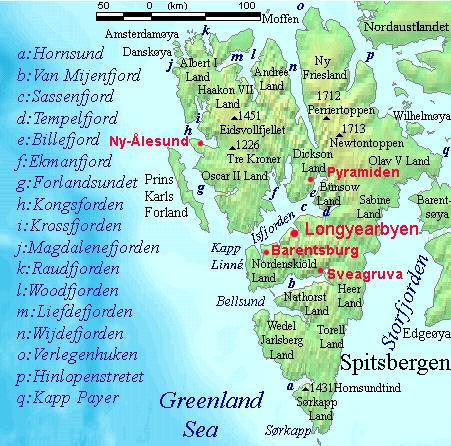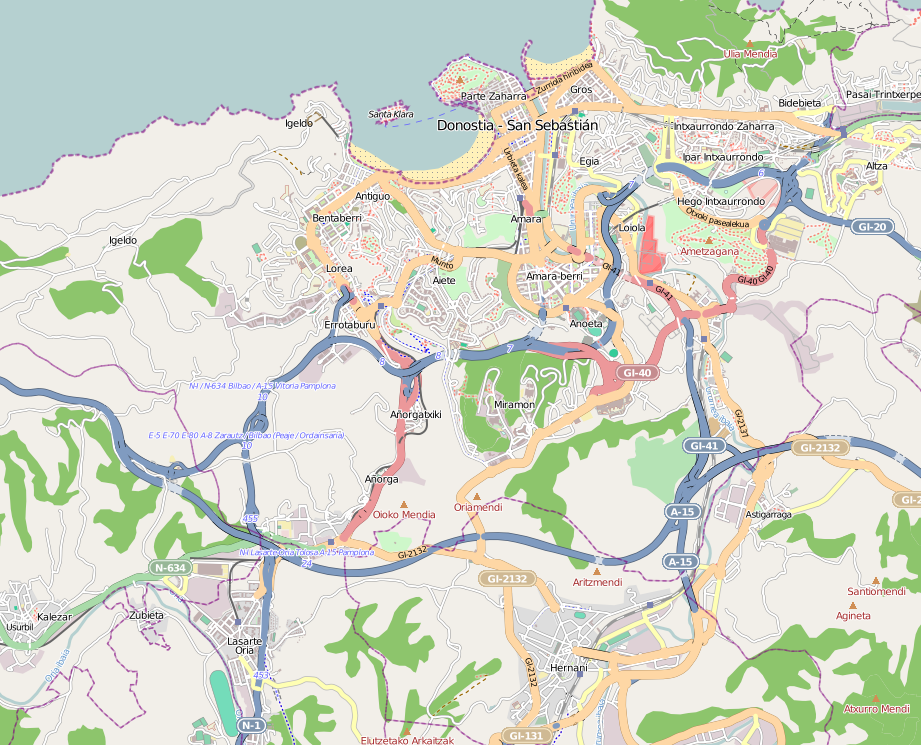|
Isfjord (Svalbard)
Isfjorden is the second longest fjord in the Norwegian archipelago of Svalbard. It lies on the west side of Spitsbergen, an island in the Arctic Ocean about midway between Norway and the North Pole, and the largest in the archipelago. The mountain of Alkhornet stands on the northern side of the entrance to the fjord, as does the coastal plain of Daudmannsøyra. A portion of Isfjorden is included in the national parks of Norway as Nordre Isfjorden Land National Park. Around the fjord lie many of the largest settlements in Svalbard: Barentsburg, Longyearbyen (on the Adventfjorden) and Pyramiden. History A Basque whaling ship from San Sebastian, under the command of Juan de Erauso and piloted by the Englishman Nicholas Woodcock, was the first to establish a temporary whaling station here in 1612. In 1613 French, Basque, and Dutch whaling ships resorted to Safehaven (Trygghamna) on the north side of Isford or in Green Harbour on the south side of the fjord. All were either d ... [...More Info...] [...Related Items...] OR: [Wikipedia] [Google] [Baidu] |
Spitsbergen Labelled
Spitsbergen (; formerly known as West Spitsbergen; Norwegian: ''Vest Spitsbergen'' or ''Vestspitsbergen'' , also sometimes spelled Spitzbergen) is the largest and the only permanently populated island of the Svalbard archipelago in northern Norway. Constituting the westernmost bulk of the archipelago, it borders the Arctic Ocean, the Norwegian Sea, and the Greenland Sea. Spitsbergen covers an area of , making it the largest island in Norway and the 36th-largest in the world. The administrative centre is Longyearbyen. Other settlements, in addition to research outposts, are the Russian mining community of Barentsburg, the research community of Ny-Ålesund, and the mining outpost of Sveagruva. Spitsbergen was covered in of ice in 1999, which was approximately 58.5% of the island's total area. The island was first used as a whaling base in the 17th and 18th centuries, after which it was abandoned. Coal mining started at the end of the 19th century, and several permanent comm ... [...More Info...] [...Related Items...] OR: [Wikipedia] [Google] [Baidu] |
Adventfjorden
Adventfjorden (Advent Bay) is a 7 km long and 4 km wide bay running south-eastwards from the southern side of Isfjorden, on the west coast of Spitsbergen in Svalbard. The name represents a corruption of ''Adventure Bay'' - probably named after the Hull-built whaleship ''Adventure'', which operated in Isfjorden in 1656. The fjord was originally known as ''Klass Billen Bay''. At the head of Adventfjorden is Adventdalen (Advent Valley). The former mining-camp of Longyearbyen (now Svalbard's main town) lies on the fjord's southwestern shore, while another former mining-camp, Hiorthhamn, is located on its northeastern shore. References *Conway, W. M. 1906. No Man's Land: A History of Spitsbergen from Its Discovery in 1596 to the Beginning of the Scientific Exploration of the Country. Cambridge: At the University Press. * Norwegian Polar Institute The Norwegian Polar Institute (NPI; no, Norsk Polarinstitutt) is Norway's central governmental institution for scientific res ... [...More Info...] [...Related Items...] OR: [Wikipedia] [Google] [Baidu] |
Svenskehuset Tragedy
The ''Svenskhuset'' Tragedy was an event in the winter of 1872–73 where seventeen men died in an isolated house on Spitsbergen, Svalbard. The cause of death was long believed to be scurvy, but research done in 2008 has revealed that the men probably suffered lead poisoning. ''Svenskehuset'' is today preserved as a cultural heritage site. The tragedy ''Svenskhuset'' (the Swedish House) is the oldest house on Spitsbergen. The house was erected by the Swedes on Cape Thordsen in Isfjorden, and was intended to withstand the harsh conditions of the Svalbard winters. A group of Norwegian seal hunters were stuck on the island in the autumn of 1872. They sought out the Finland-Swedish explorer Adolf Erik Nordenskiöld, who at the time was conducting an expedition in the area, for assistance. Nordenskiöld did not have the resources to accommodate all the hunters, so it was agreed that a number of the men would make their way to ''Svenskhuset'', where they knew there would be foo ... [...More Info...] [...Related Items...] OR: [Wikipedia] [Google] [Baidu] |
England
England is a country that is part of the United Kingdom. It shares land borders with Wales to its west and Scotland to its north. The Irish Sea lies northwest and the Celtic Sea to the southwest. It is separated from continental Europe by the North Sea to the east and the English Channel to the south. The country covers five-eighths of the island of Great Britain, which lies in the North Atlantic, and includes over 100 smaller islands, such as the Isles of Scilly and the Isle of Wight. The area now called England was first inhabited by modern humans during the Upper Paleolithic period, but takes its name from the Angles, a Germanic tribe deriving its name from the Anglia peninsula, who settled during the 5th and 6th centuries. England became a unified state in the 10th century and has had a significant cultural and legal impact on the wider world since the Age of Discovery, which began during the 15th century. The English language, the Anglican Church, and Engli ... [...More Info...] [...Related Items...] OR: [Wikipedia] [Google] [Baidu] |
Trygghamna
Trygghamna ( en, haven) is a bay in Oscar II Land at Spitsbergen, Svalbard. It is about six kilometer long, located at the northern side of Isfjorden, east of Protektorfjellet, and separated from Ymerbukta Ymerbukta is a bay in Oscar II Land at Spitsbergen, Svalbard. The glacier Esmarkbreen debouch In hydrology, a debouch (or debouche) is a place where runoff from a small, confined space discharges into a larger, broader body of water. The wor ... by the mountain chain Värmlandryggen. Historically, whalers frequently used Trygghamna as a safe harbour. References Bays of Spitsbergen {{Spitsbergen-geo-stub ... [...More Info...] [...Related Items...] OR: [Wikipedia] [Google] [Baidu] |
Netherlands
) , anthem = ( en, "William of Nassau") , image_map = , map_caption = , subdivision_type = Sovereign state , subdivision_name = Kingdom of the Netherlands , established_title = Before independence , established_date = Spanish Netherlands , established_title2 = Act of Abjuration , established_date2 = 26 July 1581 , established_title3 = Peace of Münster , established_date3 = 30 January 1648 , established_title4 = Kingdom established , established_date4 = 16 March 1815 , established_title5 = Liberation Day (Netherlands), Liberation Day , established_date5 = 5 May 1945 , established_title6 = Charter for the Kingdom of the Netherlands, Kingdom Charter , established_date6 = 15 December 1954 , established_title7 = Dissolution of the Netherlands Antilles, Caribbean reorganisation , established_date7 = 10 October 2010 , official_languages = Dutch language, Dutch , languages_type = Regional languages , languages_sub = yes , languages = , languages2_type = Reco ... [...More Info...] [...Related Items...] OR: [Wikipedia] [Google] [Baidu] |
France
France (), officially the French Republic ( ), is a country primarily located in Western Europe. It also comprises of Overseas France, overseas regions and territories in the Americas and the Atlantic Ocean, Atlantic, Pacific Ocean, Pacific and Indian Oceans. Its Metropolitan France, metropolitan area extends from the Rhine to the Atlantic Ocean and from the Mediterranean Sea to the English Channel and the North Sea; overseas territories include French Guiana in South America, Saint Pierre and Miquelon in the North Atlantic, the French West Indies, and many islands in Oceania and the Indian Ocean. Due to its several coastal territories, France has the largest exclusive economic zone in the world. France borders Belgium, Luxembourg, Germany, Switzerland, Monaco, Italy, Andorra, and Spain in continental Europe, as well as the Kingdom of the Netherlands, Netherlands, Suriname, and Brazil in the Americas via its overseas territories in French Guiana and Saint Martin (island), ... [...More Info...] [...Related Items...] OR: [Wikipedia] [Google] [Baidu] |
Nicholas Woodcock
Nicholas Woodcock (c. 1585 - after June 1658?) was a 17th-century English mariner who sailed to Spitsbergen, Virginia, and Asia. He piloted the first Spanish whaling ship to Spitsbergen in 1612 and participated in the Anglo-Persian sieges of Kishm and Ormus in 1622. Life Spitsbergen, 1610–1618 A man of the same name was sent on an expedition to the River Ob by the Muscovy Company in 1568. Seeing as how this name is not common, it is possible that Woodcock may have been a son or grandson of this namesake. In 1610, he served as mate aboard the Muscovy Company ship ''Amity'' (60 tons) on a sealing and exploratory voyage to Spitsbergen. In 1611, Purchas (1625) states that it was he who suggested to the Muscovy Company that six Basque whalers from the town of St Jean de Luz, who had experience in the Terranova whale fishery, should be shipped the following season. Using his advice, the company sent these six whalers, as well as the ''Mary Margaret'' (150 tons), Steven Bennet, ... [...More Info...] [...Related Items...] OR: [Wikipedia] [Google] [Baidu] |
San Sebastián
San Sebastian, officially known as Donostia–San Sebastián (names in both local languages: ''Donostia'' () and ''San Sebastián'' ()) is a city and Municipalities of Spain, municipality located in the Basque Country (autonomous community), Basque Autonomous Community, Spain. It lies on the coast of the Bay of Biscay, from the France–Spain border. The capital city of the province of Gipuzkoa, the municipality's population is 188,102 as of 2021, with its metropolitan area reaching 436,500 in 2010. Locals call themselves ''donostiarra'' (singular), both in Spanish and Basque language, Basque. It is also a part of Basque Eurocity Bayonne-San Sebastián. The main economic activities are almost entirely service sector, service-based, with an emphasis on commerce and tourism, as it has long been one of the most famous tourist attraction, tourist destinations in Spain. Despite the city's small size, events such as the San Sebastián International Film Festival and the San Sebastia ... [...More Info...] [...Related Items...] OR: [Wikipedia] [Google] [Baidu] |
Basque Country (autonomous Community)
The Basque Country (; eu, Euskadi ; es, País Vasco ), also called Basque Autonomous Community ( eu, Euskal Autonomia Erkidegoa, links=no, EAE; es, Comunidad Autónoma del País Vasco, links=no, CAPV), is an Autonomous communities of Spain, autonomous community of Spain. It includes the Provinces of Spain, provinces (and historical territories) of Álava, Biscay, and Gipuzkoa, located in the north of the Iberian Peninsula, bordering on the autonomous communities of Cantabria, Castile and León, La Rioja (Spain), La Rioja, and Navarre, and the Regions of France, French region of Nouvelle-Aquitaine. The Basque Country or Basque Autonomous Community is enshrined as a 'Nationalities and regions of Spain, nationality' within the Spanish State in Statute of Autonomy of the Basque Country, its 1979 statute of autonomy, pursuant to the administrative acquis laid out in the Spanish Constitution of 1978, 1978 Spanish Constitution. The statute provides the legal framework for the develop ... [...More Info...] [...Related Items...] OR: [Wikipedia] [Google] [Baidu] |






